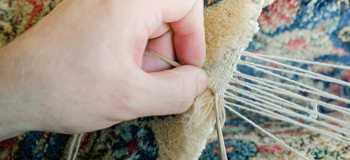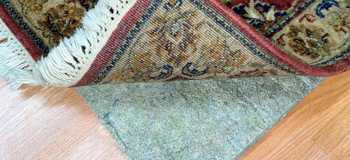WOOL MOTHS – Pesky Pests
by Lynn Tall, RugAdvocate.com
The most active seasons for wool moths are in the Spring and Fall. You may even see them flying around outside. If they’re flying, they’re mating and laying eggs. You do NOT want to let them into in your home.
When wool moths do get into the house, they immediately start looking for a place to call home. They settle into wool, silk, or other hair fiber textiles, and lay their eggs. They do this because when the eggs hatch, the larvae are already at a food source. The larvae chew at the fibers and extract as much of the protein found at the core of the fibers as they can. This causes a LOT of damage in a fairly short amount of time.
There are two types of wool moth: web-making, which is light beige in color and lays its eggs under a protective sticky web, and case-making, which is speckled light brown in color and lays its eggs inside of a protective tube-shaped case. In each instance, the adult moth is only about ¼ inch to ½ inch long.

Because moth eggs can survive for up to two and a half years, it’s important to be vigilant about removing them if you see wool moths in your home. Your vacuum won’t do the trick. The infested rugs, sweaters, coats, or blankets need to be specially contained to avoid any spreading, carefully removed, and professionally cleaned. This way, you’ll know for certain that your home is a moth-free zone.
Rugs going into storage need special treatment. They require cleaning, moth repellant, and breathable wrapping (not plastic!) with the seams sealed. They should be stored in a clean, dry, cool place away from exterior walls, and up off of the floor. We can help you with that.
When called upon, Omaha’s Rug Cleaning & Restoration will do the following:
- Inspect your home for moth activity
- Contain & remove any infected textiles from your home
- Refer a pest control company, if necessary
- Refer a qualified cleaner for all textiles not cared for by us
- Clean and treat your rugs for moth casings, cocoons, larvae, and moth eggs
- Apply a post-cleaning treatment to help repel future moth activity
- Recommend any repairs to moth damaged areas
- Recommend timeline for re-application of moth treatments
Once visibly infected textiles have been removed from your home, keep watching for other signs of flying moth activity. There may be something we missed – a bag up in the attic hiding an old wool sweater, a silk scarf high up on a shelf, an old Army blanket in a trunk – these could all be “home base’ and a source of future problems. Call us back in to inspect again if you see anything new.
Visit Us
Omaha’s Rug Cleaning & Restoration
10345 Chandler Cir
LaVista, NE 68128-3256
Hours
Mon - Fri 8:30 am - 5 pm
Closed Saturday and Sunday
Call Us Today
(402) 212-1275



